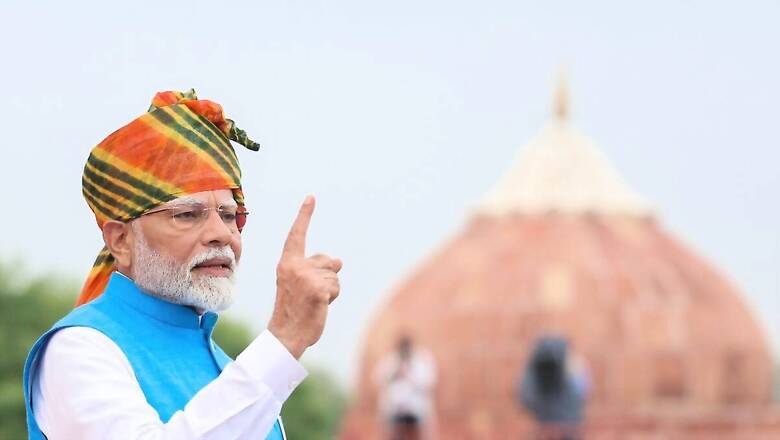
views
In December 2012, several moving slogans had emerged from the protests held in New Delhi against the gang rape that shook the nation. The most moving among them in the country-wide outrage was “Nirbhaya is every woman. I am every woman” — a slogan that individualised pain.
The calls succeeded in achieving political unity in protests that were not completely apolitical, even as they failed to achieve, as expected, societal “zero tolerance” towards gender crimes against women.
It has been 12 years since the ‘December protests’ and the streets are resounding with yet another slogan — “Beti Padhi Toh Sahi, Bachi Nahin” (The daughter did get educated, but did not survive) — as public outrage rises against the Kolkata rape-murder case.
It is perhaps this blend of emotions that made Prime Minister Narendra Modi describe the outrage as “jan-saamaanya ka akrosh” (anger of the common man) during his Independence Day speech at Red Fort.
The Red Fort Declaration of ‘Akrosh’
PM Modi did not specify the Kolkata case while speaking on women safety in India but the timely, succinct and essential mention will go down in the history of Independence Day speeches as poignant and morally courageous. It sticks out from the larger habit where accountability in sections of politics is as ragged and tattered as the public’s own understanding for the need for gender sensitivity and women’s safety.
PM Modi called for swift investigation and harsher punishments in cases of crimes against women. In the 98-minute speech, the reference to women’s safety may have been short in terms of duration, but it echoed, bleeding into the development-oriented mentions made by him. On development, the prime minister fondly mentioned the success of women Self-Help Groups (SHGs).
Modi recognises the grit and gifts in developing and harnessing sisterhood — whether of the SHGs, of prosperity, of celebration, or the sisterhood achieved by the clogging of anger, pain and tears in women’s throats.
Development is goal-driven, and goals, delivery and time-driven. In Modi’s inspiring and effective women-centric, women-led, women-oriented development politics, he must try to move towards accomplishing the time-marked goal of eliminating India’s crime against women problem.
Need Of The Hour
The time and opportunity to fix India’s crime against women problem is now. The country cannot enter the “golden era” of the build-up to 2047 without fixing the crime against women problem.
Here is why:
Reason 1: Development without women participation is unthinkable, lifeless, unsustainable and meaningless. Women participation, without women’s safety and security in all fronts and realms of life and work, is impossible, imprudent, illusive and would render the goal of 2047 either symbolic or abstract.
Reason 2: Development is power. Development involves and uses gender power. Shakti — the divine and human manifestation of the goddess propels the idea of power — from warriors in the battlefield, to the pursuit of prosperity, creation and production; to the seeking and explorations of knowledge and study. Without Shakti — the combined strengths of an empowered and safe woman — the human manifestation of Shakti — the Devi herself — is powerless. And the powerless cannot inspire the power of and for a “developed” nation.
Reason 3: Modi works on the Indic belief system when approaching development. The Indic understanding of prosperity and wellbeing keeps the Devi central — in worship, in work, discipline and adherence to domestic life and its celebration.
Reason 4: Crimes against women and the resulting fear and anxieties corrode the idea of safety of families in public consciousness. The unit of family sustains the nation. PM Modi is perceived as a nationalist. He views development as resting on the unit of home and family, which itself rests on women. Crimes against women — whether in the curtained confines of “home” or workplace or at public spaces — have the potential to rattle the very clockwork required for a developing nation.
Reason 5: Women are citizens and voters. The invisible value that connects women voters and PM Modi is trust. It is only this ‘Vishwas ki Dor’ (thread of trust) that will hold together his work for Mission 2047.
Reason 6: The prime minister must use the strength of the SHG sisterhood for the women of India. A multi-ministry approach in creating gender sensitivity in rural and urban areas, awareness of the consequences of committing a crime, and social alerting, need to be put in place.
The ‘Vishwas Ki Dor’
Harsher punishments to the perpetrators of gender crimes were a subject of debate in 2012 as well. While law and order is a state matter and punishment resides with the judiciary, the intent and drive belong to the prime minister himself.
While Modi is known for adhering to moral boundaries in his respect for the limits and limitations in the Centre-state partnership towards development, it is well known that he counts the safety, security and prosperity of women as a powerful facet of development.
As events and consequences indicate, Narendra Modi’s politics, especially during and after 2019, has been influenced by the blending of uncertainties that demand his response and the development-oriented path he tailors.
Response to the Pulwama attacks; the revoking of Article 370, anti-CAA protests, protests against farm laws and the resulting events; the pandemic and related lockdowns, the LAC-situation of 2020, vaccines to fight Covid-19, challenges related to the 2024 Lok Sabha polls, and Sandeshkhali issue are some of the major chapters arising with uncertainties that would test his resilience and exhibit his decision-making. The prime minister, at the time he was addressing each of these, was also moulding, shaping, and putting to execution several
development-oriented programmes simultaneously.
This duality in his nature of work pretty much defined and designed his previous term (2019-2024). That these two aspects of his politics directly and indirectly affect and involve women voters, their lives, their future journeys, is as much inherent in the character of our democracy as it is deeply seeded in Modi’s own work-destiny. He must treat the war on crimes against gender as the uncertain factor in governance and go all strengths after it.
In 2019, when Narendra Modi-led NDA came to power after winning a landslide victory in the Lok Sabha polls, he used the phrase “Vishwas ki Dor” to define the strong thread of trust that connected the victory to women voters. Crimes against women should hence figure as the top priority. Years and decades after he walks away from his office, he will be remembered for it.
The Development & Delivery Clockwork
Modi’s work in sculpting delivery of basics was the first indication of promise and delivery.
He remained obstinately focused on building toilets, even as the Opposition criticised him and western media smirked at his efforts. He let the impact of the Swachh Bharat Mission speak for the health, safety and physical security of women, even while the interventions under the Ujjwala Yojana, the Jal Jeevan Mission, Beti Bachao, Beti Padhao were underway. Happening simultaneously is his work on creating women-centric financial inclusion, housing, education, and entrepreneurship. In 10 years of his governance, Modi has maintained his stand and narrative on how the development in women’s own lives is India’s development.
Let’s look at some changes that Modi has brought about for women that have encouraged him to envision Mission 2047.
According to government data, as on February 2023, under the Pradhan Mantri Awas Yojana, over 2.16 crore houses were constructed of the 2.85 crore sanctioned houses. Over 69 per cent houses are either solely or jointly owned by women. Under the Pradhan Mantri Ujjwala Yojana, over 9.58 crore LPG connections were released. LPG coverage in India improved to 105.4 per cent in November 2022. In April 2016, it stood at 61.9 per cent.
About SHGs, PM Modi has said that he considers “the sisters of women self-help groups to be the champions of self-reliant India campaign. These self-help groups are actually national help groups”.
In his Independence Day speech, PM Modi mentioned SHGs, reflecting their contribution to development of women. It should be known that he, previously, has substituted the “self” in women, and their self-reliance with the “nation” and “national”.
Modi’s belief in building the connection between the woman as an individual and the “nation” as the abode and recipient of her reliance and fulfilment has base in the strengths of SHGs. Women’s access to formal credit, the support they receive for the strengthening of their livelihood initiatives, and a potent women-led support system, have led to the mobilisation of 9.73 crore women as in September 2023 in 89.4 lakh SHGs under the Deendayal Antyodaya Yojana-National Rural Livelihood Mission.
A newly created, vibrant narrative on the socio-cultural linking of schemes such as Sukanya Samriddhi Yojana with SHGs will go a long way in cementing generational evenness in self-reliance of women, and their children — particularly the girl child.
As creative leaders and shapers of the Indian family unit, women across roughly three generations would become discerning contributors to India’s development story towards the centenary celebrations of India’s Independence. What would be more apt that celebrating self-reliance in women and a developed nation made self-reliant by self-reliant women in 2047?
Why Work For 2047 Begins In 2024
Modi’s success in setting the pace for Mission 2047 would seed itself in how his government during this term maintains the “change installed” under the Swachh Bharat Mission. Government data mentions that 93 per cent women reported that they were no longer afraid of being hurt by someone or harmed by animals while defecating. Also, 93 per cent women reported they are no longer afraid of contracting health infections.
Bringing a multi-ministry convergence in a massive project on transforming India’s collective consciousness on “beti” — the unborn, the newborn, the growing, students, working women, homemakers, pregnant women, working women, and mothers — needs to be seen in a new single and unified beam of concern, vision and work. This will ensure the breaking down and dissolving of prejudices that lead to unjust attitudes and actions towards women in all stages of life.
Modi has proudly worn the headgear of being the “patriarch”. His mention of women’s menstrual health, sanitary pads and his pitch for taking the problem of cervical cancer and vaccination to fight it seriously, in prime speeches, has set the tone for future decades.
Giving women the opportunity to take charge of their own economic survival, domestic prosperity and simultaneously of India’s development is the fulfilment of that “purpose”.
“Recognition”, “being valued”, “dignity”, “savings”, “pool”, “nation”, “unity” are recurrent words that have marked my own interactions with women part of SHGs. Harnessing women’s resilience, ideas, creativities and strengths in a work mutation of sorts in formidable caste, community, village and urban level convergences requires a tireless and continuous identification of those convergences.
Women achieving 37 per cent labour force participation, the rise in entrepreneurship among women, the dominance of women when it came to loans sanctioned under PM Mudra Yojana (68 per cent — according to Economic survey 2024) — all point to rising women entrepreneurship and the dominance of women in Stand-Up India.
The harvest of promise in Sukanya Samriddhi Yojana — designed exclusively for the financial stability of the girl child — will become evident when girls touched by the scheme begin to contribute to lives, education, work force and as the bearers of power in the domestic set-up.
The Modi government has done little to celebrate the impact of its own initiatives during the last 10 years. Since the inception of Sukanya Samriddhi Yojana, around 3.10 crore accounts have been opened under the scheme, says government data. If the government tracks success stories of only a thousand account holders from this figure, in conversations with their guardians, several possibilities, ideas, lessons and precious inferences for futuristic developmental work and vision towards 2029-2034 will emerge.
Views expressed in the above piece are personal and solely those of the author. They do not necessarily reflect News18’s views.


















Comments
0 comment